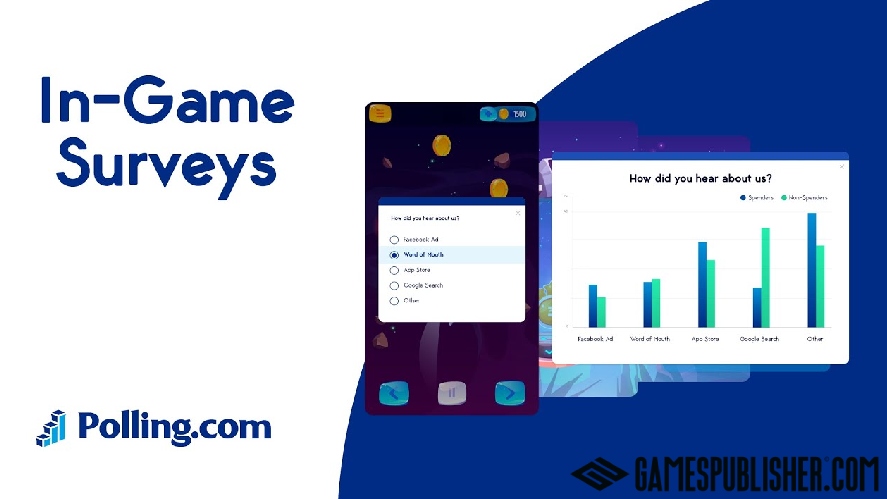Data analytics plays a vital role in the gaming industry to achieve sustainable success.
Using data analytics in video games offers many benefits to developers, such as helping them understand player behavior, optimize marketing strategies, and enhance game development.
There are two ways to collect valuable data: surveying and polling.
These ways get data based on potential players or current players. Once analyzed, they provide insights that complement traditional data analysis.
Understanding Data Analytics
Data analytics turns collected information into meaningful results that help developers make better decisions.
In game publishing, data analytics is critical.
Using data analytics, publishers can make intelligent decisions about developing games, marketing them, and attracting players.

For example, video game publishers can know which games have features players like and which don’t. This information helps the game improve.
Predicting what players will want also helps plan updates and new releases.
In addition, understanding market trends also helps investors make choices about pricing and promotion strategies.
Types of Data Analytics
Data analytics can be classified into four basic types:
- Descriptive
- Diagnostic
- Predictive
- Prescriptive
Descriptive analytics focuses on reviewing past events to create detailed reports and summaries. This helps developers understand what happened before.
Second, diagnostic analytics goes deeper to understand why something happened.
For example, it could explain why player engagement suddenly dropped.
Next, developers can form insightful predictions about potential or limited future events and trends through predictive analytics by analyzing historical data. It can predict things like which players might stop playing.
Finally, prescriptive analytics will provide advice on what to do next.
It suggests the best actions to achieve a goal, like when to release a game update or start a marketing campaign.
Each type of game analysis helps you make better decisions and improve your strategy.
The Role of Data Analytics in Game Development
Data analysis improves game design by examining player feedback and behavior.
Developers use data to understand how players interact with the game and what they like and don’t like. This information helps make the game better.
Data also helps track players’ engagement levels and engagement with the game.
Developers can see if the game captures their interest by seeing how many players keep playing and how often they play.
If players are leaving the game or not participating as much, it’s a sign that changes may need to be made.
Additionally, data helps balance game mechanics.
If data shows that some parts of the game are too complicated or simple, the developer can make adjustments to ensure the game is challenging but fair.
For example, if a level is too difficult for most players, the developer can lower it to make it more interesting.
Data-Driven Marketing Strategies
Data analytics helps game publishers improve their marketing in many ways.
First, data gaming analytics allows you to market and advertise your game based on player demographics and interests to achieve success.
By collecting player details like age, location, and interests, publishers can send specific messages and offers to different groups.
If data shows that younger players like adventure games, publishers can focus advertising on games for that age group.
This makes marketing more relevant and effective.

Second, analyzing the data helps developers manage their advertising spending intelligently.
Game developers can track how well different ads perform so you can see which ads perform best.
Then, you can spend more money on ads that attract the most players and cut back on ineffective ads.
For example, if social media advertising attracts more players than other types of advertising, publishers can invest more in social media.
Finally, data game analytics makes marketing more personal.
After analyzing players’ likes and how they play, publishers can offer personalized offers and deals.
This personalized approach makes players feel more valued and increases their satisfaction.
Monetization Insights
Looking at data will help developers know which items players buy the most and which items they ignore.
For example, if a player buys many virtual clothes but not a lot of virtual currency, the store can be adjusted to offer more clothing options.
The data also shows the best times for players to make purchases, so special offers can be timed to align with these times.

Data also helps create and improve game subscriptions.
Researching how players use games and what they like will help developers create subscription options that better suit their needs.
The data can also show how long players are subscribed, helping to set the right subscription length and price.
If players frequently unsubscribe, data can help determine why and what changes might make them stay.
By continuously analyzing registration data, you can make your plan more attractive and make players happier and more likely to subscribe.
Finally, video game analysis is vital to getting the most money from advertising by seeing how players interact with ads.
Developers can determine which ads perform best by examining how often ads are viewed, how many players click on them, and how players respond.
Tools and Technologies for Data Analytics in Game Publishing
In the gaming industry, there are several popular tools to understand how players use games, such as:
- Google Analytics: This tool is widely used and shows which parts of the game players like and how long they spend playing.
- Mixpanel: Mixpanel tracks specific actions, like how often players complete levels or purchase items.
- Unity Analytics: It is integrated into the Unity game engine and provides information about player details, progress, and spending in the game.
These tools help game developers see essential data and make their games better for players.
So, how do you integrate data analytics tools into your game to make decisions about publishing or improving it?
First, choose the tool you need.
Next, add the tools to the game by including some software components.
Once set up, the tool will start collecting data about how players interact with the game.
Developers can choose what to track, such as how many levels players complete or how often they purchase.
Once the game is online, the tool will continue to collect data, helping developers understand player behavior and improve the game.
And don’t forget, keeping player gaming data safe is very important.
You must also comply with privacy laws, like GDPR in Europe or CCPA in the US.
This means having a clear privacy policy that explains how player data will be used and asking players for permission before collecting their information.
Game publishers must focus on privacy and security, ensuring that player information is always protected.
Surveys and Polling for Data Gathering
Surveys and polls are potent tools for gathering qualitative data from players, providing insights that data analysis alone may miss.
While data analytics provides numerical data and trends, surveys and polls collect players’ personal opinions, feelings, and recommendations.
For example, video game analytics may show players leave the game at a particular time but not explain why. However, a survey can ask players about their experience and gather detailed feedback on what they liked or didn’t like.
So, by asking players open-ended questions or providing multiple-choice options, surveys can reveal problems or desires that aren’t apparent from quantitative data alone.
This information is valuable for improving game design, addressing player concerns, and making changes that may not be obvious through game analysis.
Tools for Conducting Surveys and Polls
Here are a few tools to help you create surveys and polls:
- Polling.com: This is one of the popular tools that allows you to instantly set up and share polls to get opinions quickly.
- SurveyMonkey: It provides tools to conduct diverse surveys with rich question types, allowing you to collect and analyze detailed and in-depth feedback.
- Google Forms: This tool works with other Google services. It lets you create surveys, collect responses, and view results easily.

With these tools, you can combine survey responses with data analytics to help developers understand what’s happening and why.
Feedback from these surveys can help developers make significant changes, like adjusting gameplay balance or improving the story.
Another example is when a game company surveys players to determine which features or updates they want most.
Information gathered from these surveys can guide future updates and marketing plans, ensuring they meet what players want.
In both cases, surveys provide valuable gaming insights that can significantly impact game development and improve player experience.
Case Studies and Success Stories
An example of how data analytics has helped a game publisher is Electronic Arts (EA) with their game “FIFA“.
EA looked at data about how players played the game and what they liked or disliked.
The data analysis showed that more than 40% of players had difficulty with defensive strategies, leading to a feeling of unfairness in the game.
EA publishers also ask players for feedback through surveys to clarify this issue.
In a 2023 survey, 30% of FIFA players said they were dissatisfied with the game’s AI (artificial intelligence), specifically the defensive AI.
After receiving feedback from the survey, EA has made changes in version 2024, explicitly improving defensive AI. Survey results after the change showed that player satisfaction increased by 25%.
Another example is Riot Games’ League of Legends.
Riot Games analyzed data from the game and found that 25% of players felt dissatisfied with the imbalance in their champions and abilities in the match.
Similarly, in a 2023 survey, 35% of players felt that recent updates diminished their gaming experience due to a lack of balance between champions.
By looking at both data and survey responses, Riot Games can make better decisions about updates and changes.
Conclusion
In conclusion, data analytics is essential for game publishers.
On the one hand, surveys and polls are also helpful because they clearly show what players like and what needs to be fixed.
Thus, game developers and video game publishers should use data and surveys to improve games.
Loading survey...

